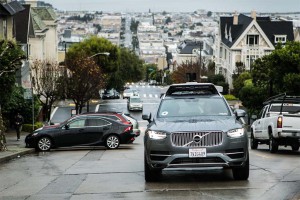As if Uber doesn’t have enough trouble with its management shake-ups, sex harassment investigations and financial issues, the ride-sharing giants autonomous vehicle program has been running into a series of serious issues.
After resolving a dispute with California regulators, Uber this month relaunched its self-driving test program in San Francisco. It also has autonomous prototypes operating in Pennsylvania and Arizona. But those vehicles can barely go a mile, it seems, without having to have their human “operators” take over control, according to Uber data.
That’s in sharp contrast to the experience reported by Google’s Waymo autonomous vehicle unit, which recently reported a sharp decline in the number of instances where humans had to snatch control away from the onboard autopilot system.
(Another day, another problem, as Uber’s new president resigns. Click Here for the latest.)
In an internal Uber report obtained by website Recode, the service’s 43 pilot vehicles clocked just over 20,000 miles in autonomous mode. But, on average, their human operators had to intervene in some form or another about once every 0.8 miles, that was actually worse than in January, when the average intervention rate was once every 0.9 miles.
That backs up reports from San Francisco where, in December, Uber briefly launched a pilot program using modified Volvo XC90 SUVs. Before the California Department of Motor Vehicles revoked their registrations, those vehicles were repeatedly observed committing moving violations such as running red lights and swerving into bicycle lanes.
Uber pulled the vehicles out of its headquarters city but recently received the necessary state permit and has relaunched the project there. It also is testing autonomous vehicles in Pittsburgh, where it now has a self-driving vehicle research center, and in parts of Arizona.
Embattled Uber CEO Travis Kalanick is a big proponent of not just autonomous vehicles but more advanced driverless cars. He has repeatedly suggested that by eliminating human drivers entirely, Uber will be able to cut the cost of its services to the point where it would be cheaper to hail a ride than own a personal automobile. Rival Lyft has espoused a similar goal and, not so coincidentally, Ford Motor Co. says ride-sharing services will be a key market for the fully driverless vehicles it plans to put into production in 2021.
(Waymo sues Uber for theft of autonomous vehicle intellectual property. Click Here for the story.)
For now, while automakers are allowed to operate autonomous vehicles on public roads in a number of states, they must keep those human operators at the ready. But California recently announced plans to permit the testing of fully driverless models – which may not even have steering wheels, pedals and controls for a backup operator to use in an emergency.
The Uber test data would suggest the company is not yet ready for that level of testing.
Waymo says it is, however, CEO John Krafcik in January reporting that the number of times its own operators have had to take control has declined sharply in the past year, even as it has been fielding more and more vehicles clocking ever more miles.
Waymo now only is running some early, modified Lexus RX utility vehicles, but a fleet of bubble cars of its own design – some of which are being built without driver controls. The Google spin-off in January also unveiled the first of 100 specially modified Chrysler Pacifica minivans fitted with a new generation of LIDAR, radar and other sensors of Google’s own design and production.
If there’s a positive side to the internal Uber report, it’s that most of the instances where humans took control were minor. The data showed that so-called “critical interventions,” where a potentially serious collision with another vehicle or a pedestrian might have happened, occurred far less frequently, on average about once every 200 miles.
That’s still far from the sort of number that suggests Uber is ready to start assigning its autonomous fleet to start taking over commercial routes across the country.
(Uber hires former U.S. Attorney General to investigate harassment claims. Click Here for the story.)



